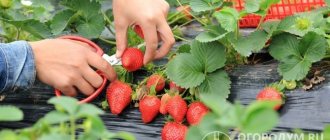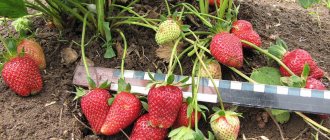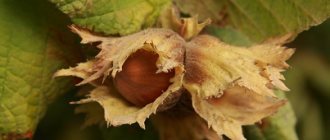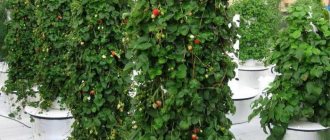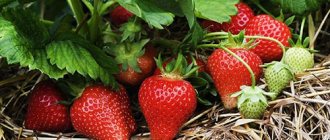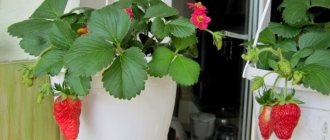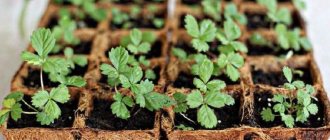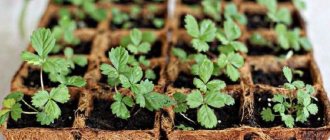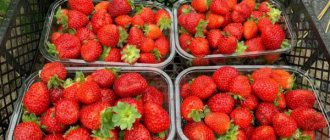In this article we will look at the difference between strawberries and wild strawberries.
Strawberries are one of the most favorite berries among the population of our country. It is used to prepare various desserts, jams, preserves, compotes and tea.
However, many people confuse strawberries with wild strawberries, being confident that there is no difference between them, although in fact they are radically different. In order to understand the difference between these berries, as well as how to plant them correctly in a summer cottage, we will consider all their properties.
What are strawberries and strawberries, and what do they look like?
Strawberry and wild strawberry plants belong to the Strawberry genus of the Rosaceae family. They are similar in appearance, but have a number of distinctive qualities.
- The fruits of ripe strawberries are scarlet in color.
- The shade of ripe strawberry fruits can vary from red to dark brown
- Strawberries look like a small bush (20-25 cm), which consists of several stems in the center and leaves along the side edges
- Strawberries look like a mundane bush and range in height from 25 to 32 cm, depending on the variety. There are leaves on the sides, and “tendrils” stretch along the center of the ground - stems, thanks to which the process of reproduction occurs
- The fruits of garden strawberries are larger than those of wild strawberries
Type of strawberry
- Strawberries are usually large, about 2-7 cm, depending on the variety
- Small strawberry fruits: 0.5-2 cm
- Garden strawberries can reach 2-4 cm in size
- When cut, the strawberry has white tissue inside, a stem and seeds along the entire outside.
- Strawberries also have seeds on the outside of the fruit, and the inside is a rich red color.
- The fruits of garden strawberries do not have bitterness, unlike wild strawberries.
Features of cultivation
Strawberries are not difficult to grow. It grows in the same way as any fast-growing plant that reproduces by tendrils. You just need to provide enough space to grow it. It is suitable for any soil, as well as the degree of lighting: from partial shade to a sunny meadow. It withstands dry conditions well, but it will be better if you organize regular watering. This is especially important in hot weather.
Replanting and propagating the plant is easy, as the shoots grow regularly. When replanting, do not bury the root rosette deeper into the ground than it grew in the previous place. Gardeners mulch the area around it with straw or sawdust to prevent the berries from coming into contact with the soil and rotting.
Eating any variety of strawberry berries is very beneficial for health. But do not forget that any food is good in moderation and you should not eat more than 1 kg of fruit per day to avoid intestinal problems.
How to distinguish wild strawberries from strawberries by leaves?
To distinguish strawberries from garden strawberries, just look at the leaves of the plant. However, it is not only by external data that one can determine the type of berry. Strawberries have the following characteristics:
- Peduncles are located significantly higher than the foliage
- The berries are not tilted downwards
- Leaves and fruits have a musky aroma
- Plants are grown in the shade in places with high humidity
- The leaves are corrugated or light green, but they are always large
Strawberry leaves
Strawberry has the following qualities:
- The leaves are oval, ovate, trifoliate or ovate-rhombic in shape.
- The edges of the leaves are always serrated
- Their shade is usually a rich green color.
- Leaves are large or medium, depending on the bush
- The bottom of the leaf is always omitted
- Leaves and fruits are always fragrant
Do I need to wash it?
After the strawberries are cleared of the remaining greens, which usually yield quite easily, they are washed in medium-temperature water and laid out on rags, paper or towels.
You can also immediately use a specially prepared clean container when picking wild strawberries, while being careful not to allow various debris, such as twigs, leaves and various insects, to get there. In this case, there is no need to sort the strawberries, nor to wash them. It is immediately used, without undergoing any preparatory treatment, to make compote or jam.
Advice! It is recommended to wash meadow strawberries after picking.
If it happened that on the way home the berries were still crushed, but they were collected with care and attention, that is, they were not thrown into a container, but carefully folded, you can not wash the strawberries and immediately make the jam
Picking the berries of this useful plant is not considered an easy task, however, the positive emotions from this activity more than offset all the difficulties. In addition, strawberries are very tasty; jam and other sweets are made from them, and they are also a remedy for many ailments. When the beneficial properties of the plant have been studied and it has been stored for the winter, according to the rules, you can purchase a tasty and healthy product at home without special expenses.
Why are garden strawberries called strawberries?
Garden strawberry is the correct name for strawberries, which are usually grown in summer cottages and backyards of cottages. It has several varieties and differs in size, sugar content and taste. There are 3 options for the name of this garden berry:
- Strawberry
- Strawberries
- Victoria
Strawberries, not strawberries
Each of them has its own origins:
- The berry began to be called strawberry back in ancient Rome. This was facilitated by its shape, as well as the presence of small grains on the surface, which were repeated in the miniature form of the fruit.
- The name “strawberry” comes from the way this berry grows. Because it ripens when close to the ground. In our country, wild berries that grow in the forest or in clearings are called strawberries.
- The berry received the name “Victoria” at the beginning of the 20th century. Workers at the Versailles Garden mistakenly planted different varieties of strawberries in neighboring beds. After pollination, the fruit had a different taste and shape, which was loved by the nobility.
People call strawberries strawberries and vice versa, in most cases due to ignorance of the properties and appearance of the berries.
Frequently encountered difficulties
A frequently occurring problem: the bush blooms, but there are no berries. The reason may be:
- frostbite of the stigma;
- weed variety;
- lack of pollination.
To avoid this problem, gardening work should begin in early spring. Main spring events:
- clearing beds of last year's grass;
- loosening;
- feeding;
- mulching.
Strawberries and strawberries have many distinctive features. The climatic conditions of central Russia are quite suitable for cultivating most of the currently existing varieties of these berry crops.
0 0 votes
Article rating
What is the difference between strawberries and strawberries: comparison
Strawberries and wild strawberries in the botany classification belong to perennial herbaceous plants of the Strawberry genus of the Rosaceae family. However, both berries have a number of differences that will help you recognize the necessary plant and properly care for it. Among the main differences are:
- The height of the stems (strawberries range from 25 to 32 cm, depending on the variety, and strawberries from 20 to 25 cm)
- Size and shape of flowers (strawberries are unisexual, while strawberries are bisexual)
- Leaves (strawberries are light green or ruffled)
- Harvest (garden strawberries produce more fruit than strawberries)
- Smell (strawberries have a more pronounced aroma than strawberries)
And here is the strawberry
- Size of berries (strawberries have larger fruits than garden strawberries)
- Growth method (strawberry leaves are not located on the ground, unlike garden strawberries)
- Population (real strawberries are not found in the wild, and in the CIS countries garden strawberries are predominantly cultivated)
Raspberry with strawberry flavor
There cannot be a hybrid of raspberries and strawberries. Strawberries are herbaceous plants, and raspberries are shrubs. But in East Asia, a variety of raspberries with strawberry flavor grows under natural conditions - this is strawberry-raspberry. She also owns the following names:
- seductive;
- Chinese;
- Tibetan;
- Himalayan;
- strawberry;
- strawberry;
- dwarf;
- rosaline or roseleaf.
In addition to the pleasant taste of the berries, the bush itself has decorative value. It has beautiful rose-like leaves and lovely large white flowers. This variety is characterized by the simultaneous presence on the bush of both flowers and large bright pink fruits that taste like strawberries. True, the berries are not suitable for transportation and therefore it is almost impossible to find them on sale.
What is healthier, better, more productive, more aromatic, tastier: strawberries or strawberries?
There are about 30 varieties of strawberries. The most popular varieties are:
- Sadovaya
- Lesnaya
- Chilean
- Eastern
- Virginskaya
- Large-flowered
The most popular strawberry varieties include:
- Gigantella
- Mara de bois
- Albion
- Mashenka
- Festival
- Marvelous
- Maksim
- Lord
- Honey
- Kimberly
Selecting a variety
When choosing berries for cultivation, you should consider:
- Garden strawberries produce more fruit than strawberries
- Strawberries are more flavorful
- Strawberries are sweeter
- Strawberries have a sour aftertaste
- Both berries can be used as a base for preparing various dishes.
- Strawberries are smaller in size
Unambiguously answer the question: “Which berry is healthier and tastier?” - impossible. After all, each variety has a number of specific qualities that distinguish it from the rest.
Late varieties
Strawberries and wild strawberries
These strawberry varieties can produce a harvest before the first frost. The berries are great for making jam and confiture.
Gigantella
A late-ripening variety with large, flat, blood-red berries. When cut, the berry is dense with a pronounced bright taste and aroma. The bush develops powerfully and produces quite a lot of tendrils. Care must be timely. And this: fertilizing, thinning rows, watering. Failure to comply with agrotechnical conditions leads to a decrease in the yield and quality of berries.
Bohemia
This variety is unpretentious to grow. During dry summers, the quality and quantity of the harvest does not decrease. The plant does well in poor loamy soil. The fruits are quite large and dense. This variety is recommended for long-term fresh storage, as well as for preparing for the winter as jam or preserves.
Chamora Turusi
The variety is large-fruited and high-yielding. Can bear fruit until the coldest weather. The plant needs to be watered and thinned frequently. The bush is spreading with numerous flower stalks. The first wave of berries can weigh up to 100 grams. Then, towards the end of flowering, the berries become smaller. The fruits are sweet and juicy.
Pensioner Chelsea
This variety appeared recently, but has already managed to please many gardeners for its tasty and dense fruits. The bush bears fruit for a long time, provided good watering is provided. Young seedlings will not yet produce a good harvest, but next year, if all conditions are met, you can be pleased with an abundance of tasty and sweet fruits.
Vima Rina
The bush is quite powerful and spreading. The fruits are large, slightly elongated. The pulp of the berry is juicy, dense with a sweet and sour taste. The plant tolerates dry periods well and easily adapts to changing climatic conditions. Recommended for transportation and long-term fresh storage.
Vitamins in strawberries and wild strawberries: where is there more?
It's no secret that berries are rich in microelements, antioxidants and other useful components. Strawberries contain vitamins: C, E, A, B. Strawberries are a storehouse of C, E, B, H, PP. The highest concentration of vitamins is found in wild berries.
In addition, a considerable amount of minerals and antioxidants are found in the leaves of plants. For example, strawberry decoction is used for the following diseases:
- Enterocolitis
- Underweight
- Pathologies of the spleen
- Atherosclerosis
- Hypertension
- Constipation
- Haemorrhoids
- If there are parasites
- Frequent acute respiratory infections
- Ulcer
Strawberry leaves and fruits are widely used in the presence of the following diagnoses:
- Pharyngitis
- acute respiratory infections
- Laryngitis
- Inflammation of hemorrhoids
- Stomatitis
- Depression
- Intestinal disorder
- Poisoning
- Streptococcus
Properties of the berry
Vitamins and microelements are contained in approximately equal quantities in these berries. However, it is worth remembering that when choosing strawberries for medicinal purposes, it is necessary to choose those that have grown in the wild, or those fruits for the growth of which chemical fertilizers and pesticides were not used.
Nutrients
| The nutritional value | Strawberries | Strawberry |
| Calorie content | 146 kcal | 49 kcal |
| Zhirov | 2.5 g | 0.5 g |
| Carbohydrates | 7.0 g | 117 g |
| Sahara | 5.0 g | 7.4 g |
| Squirrel | 23.0 g | 1 g |
| Fiber | 0 g | 0 g |
Strawberries are an excellent source of antioxidants, vitamins A, C, E and B, as well as minerals such as potassium, manganese, fluoride, copper, iron and iodine. Various diseases and complications - diabetes, gout, high cholesterol and atherosclerosis can be prevented with a 12-day strawberry treatment.
This therapeutic diet can also reduce the symptoms of rheumatism if combined with sunbathing on the affected area of the skin. In the absence of allergies, strawberries can treat acne, dermatoses and psoriasis. Its fruits catalyze the healing process.
Strawberries have a low glycemic index of 40. This means they have little effect on blood glucose levels or insulin response, making them suitable for diabetics. It is rich in fiber, vitamin C, potassium and antioxidants such as anthocyanins and quercetin. Fiber helps maintain gut health. A large amount of potassium will help normalize blood pressure and prevent coronary artery disease.
Quercetin and flavonoids found in strawberries have been shown to reduce inflammation, blood pressure, and other risk factors for cardiovascular disease. Anthocyanins are plant pigments that provide the red color of strawberries. They have antioxidant and anti-inflammatory properties that are important for the overall health of the body.
Is it possible to plant strawberries next to strawberries and at what distance?
In order to plant strawberries, a large number of methods are used. Among them are:
- Bush
- Private
- Gnezdovoy
- Carpet
To plant strawberry bushes, the soil is first prepared. If there is no more free space on the site, then you should take into account several recommendations:
- You should not plant more than 4 varieties of strawberries or wild strawberries nearby.
- Bushes should be placed at least 30 cm apart from each other
- You need to choose different areas for planting strawberries and wild strawberries, since these plants react differently to humidity and sunlight
Planting berries
It is also recommended to arm yourself with the following plan when planting strawberry bushes:
- The distance from bush to bush in one bed is kept within 30 cm
- It is also important to maintain a distance of 30 cm on other sides
- The passages between the beds must be at least 70 cm, and when planting strawberries - 90 cm
In order to properly plant strawberry bushes, you must adhere to the following rules:
- The soil is cultivated to a depth of 7-8 cm using a rake
- After this, it is necessary to level the entire ball of soil
- Next, you need to compact the soil
- When forming rows, you need to maintain a distance of 70 cm between the beds
- The distance from bush to bush is minimum 15 cm and maximum 30 cm
- When planting fruits in one bed, it is also important to maintain a distance of 30 cm
- If you use a low view, then a sufficient distance is 25 cm
- In case of planting tall bushes, it is necessary to leave 35 cm
If you need to place strawberry and wild strawberry bushes side by side, be prepared for the two varieties to mix. Indeed, during the process of pollination they can mix, which is why the harvest may be lost. Therefore, it is necessary to follow all the above recommendations, as well as carefully select strawberry varieties so that the harvest is rich and delights you for many years.
Notes
- For the convention of indicating the class of dicotyledons as a superior taxon for the group of plants described in this article, see.
- The Latin generic name comes from Lat. fragare - to smell fragrant.
- ↑
- ↑
- ↑
- ↑ Strawberries
- article from the Great Soviet Encyclopedia. - Yagoda
- article from the Great Soviet Encyclopedia. - Ivashin, D. S. et al.
Medicinal plants of Ukraine. - K.: Harvest, 1974. - P. 142. - Remontant strawberries: description and cultivation
↑ Russian name of the taxon - according to the following edition:
- ↑ Russian name of the taxon - according to the following edition:
- ↑ Strawberries
- article from the Great Soviet Encyclopedia. - Club 2: Strawberry // Explanatory dictionary of the living Great Russian language: in 4 volumes / author's compilation. V. I. Dal. — 2nd ed. - St. Petersburg. : Printing house of M. O. Wolf, 1880-1882.
- Fragaria elatior // Botanical dictionary / author's compilation. N. I. Annenkov. - St. Petersburg. : Imp. Academy of Sciences, 1878. - P. 146.
Preparatory work before planting
Growing strawberries in the country begins with preparing the soil, especially if the area has not been cultivated before, and purchasing healthy planting material.
Wireworms and chafer larvae can become a threat to young plantings. One such larva can destroy up to 1 square. m landing. How to grow strawberries in such soils? First, the land must be treated against pests with an ammonia solution or other insecticides. You can pre-plant alkaloid lupine in the garden bed. Eating its beans, the larvae die.
Many summer residents are interested in how to grow strawberries in an area with close groundwater. Where the waters come close, the height of the formed bed should be about 40 cm. In other, drier areas - up to 10 cm, or you can do without forming beds at all. The standard width of the beds is 1 m.
To obtain high yields when growing in open ground, special attention is paid to planting material. Seedlings of elite varieties or first reproduction, sorted and pre-healthed, will allow you to grow a lot of strawberries
How to choose good seedlings? Signs of quality seedlings:
- shiny leaves of rich green color;
- fibrous root system with shoots reaching 7-8 cm;
- The diameter of the root collar is at least 6 mm.
If you plan to grow strawberries in open ground in the spring from your own seedlings, then at the end of autumn the seedlings are dug up and placed in the cellar. About 5 days before planting, the box with seedlings is taken out and placed in the shade.
Should I leave the male bushes in the garden or is it better to remove them?
In general, many modern varieties of berry crops are self-pollinating, but they can bear fruit for only 3-4 years, after which it is necessary to replace the plants with new ones.
Old, time-tested varieties can bear fruit not just for 3, 4 or 5 years, but produce crops for decades. But they need to have different types of instances.
Therefore, if you plant only modern varieties of berry crops, and also regularly update them, then there is no particular point in leaving the “boys”.
If your strawberry plantation is many years old, then the presence of “male” plants is mandatory, otherwise there may be no harvest. At the same time, make sure that they do not take over the entire space.
No matter how strange it may sound, you can try to “change sex” for male bushes, that is, turn them into well-fruiting female specimens. To do this, they use this trick.
Collect several of these bushes and plant them in a separate area close to each other. All antennae must be trimmed immediately after they appear. If you quickly remove them throughout the season, then in August flower buds will begin to appear on the rosette. After this, these specimens are returned to the main plantation. Fruiting of the renewed plants will begin next year.
